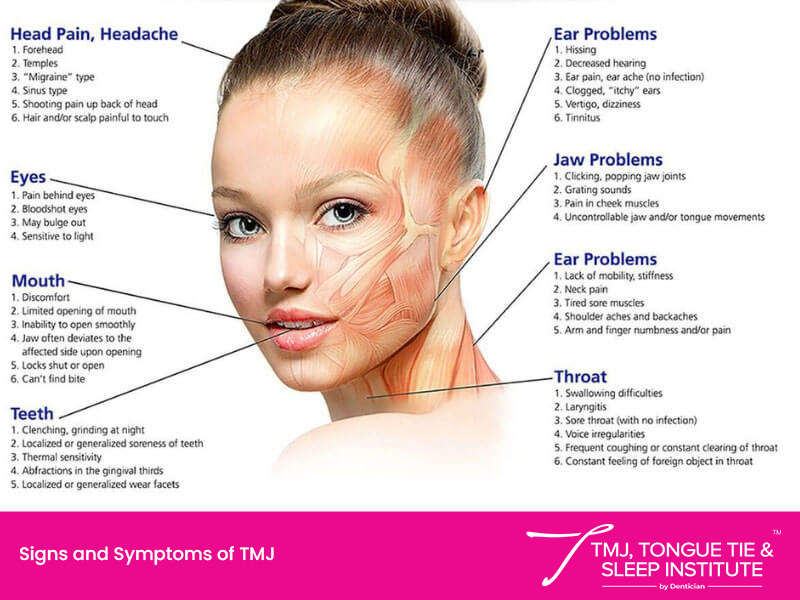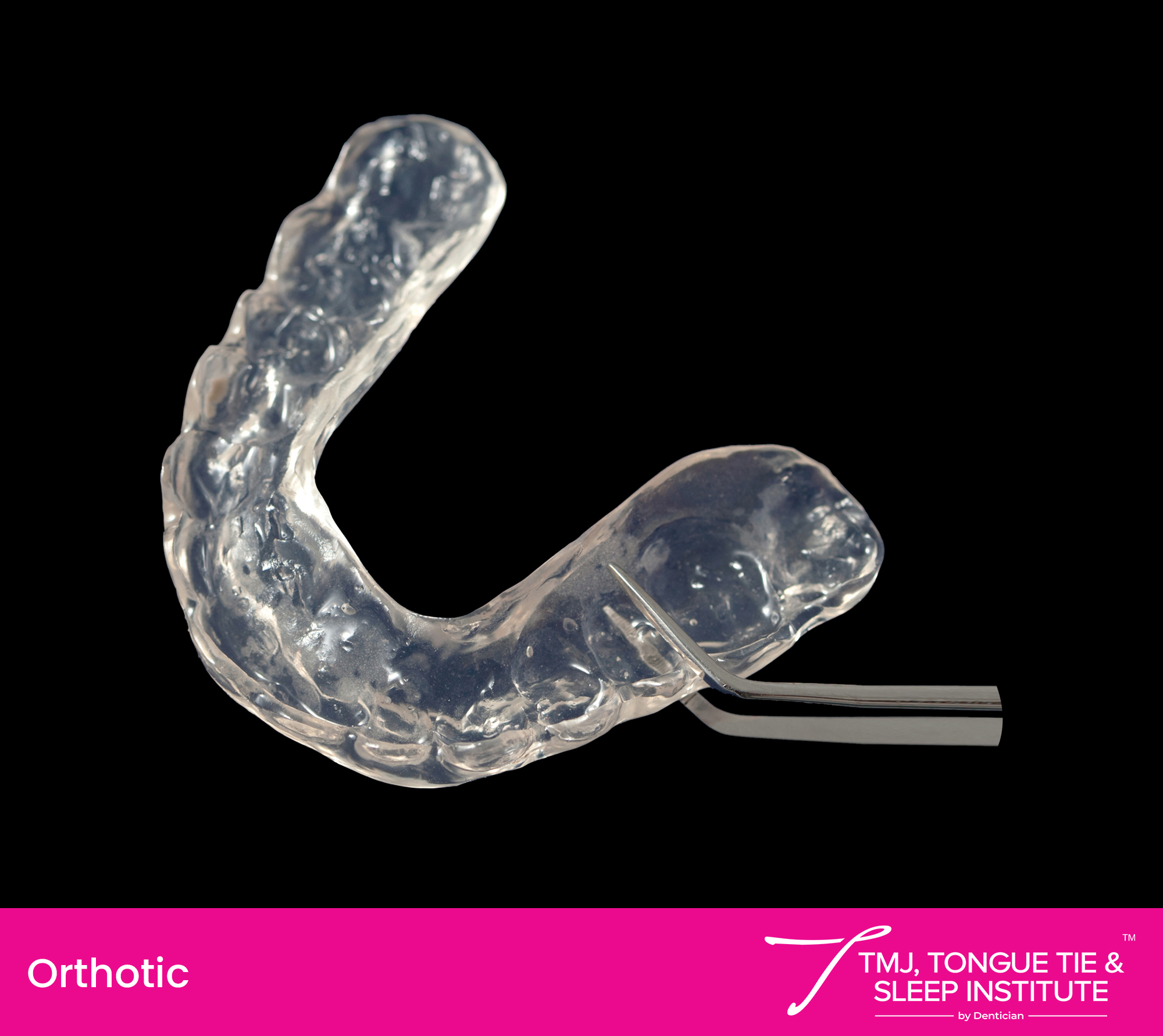HOW TO KNOW IF IT IS TMJ DISORDER OR SOMETHING ELSE? Written By: Dr. Ankita Shah, 15 October 2023

TMJ pain has been reported in 1 in 10 people, and TMD (Temporomandibular Joint Dysfunction or Disorder) has been reported in almost half of the population. It is one of the most common complaints dental practices encounter, and is mostly caused due to malocclusion. Malocclusions is the imperfect positioning of the teeth when the jaws are closed. This imperfect positioning changes the relationship of the mandible to the cranium causing a person to suffer from head, face, neck, shoulder and back pain. Some people can also suffer from subjective hearing loss, ringing in the ears, dizziness, pain in the ear and the feeling of pressure in the ear.
So let’s take a look at how it is all connected.
As one of the complex joints in the body, TMJ along with several muscles allows the mandible to move up and down, side to side and forward & back. Thus, it is only when the mandible and joints are aligned, would actions like chewing, talking, yawning, and swallowing become easy and seamless.
However, when these structures, i.e. the muscles, ligaments, disk, jawbones and teeth are not aligned or synchronised, a TMJ disorder (TMD) may occur.
Put an end to your TMJ discomfort. Take our easy TMJ disorder assessment and discover if you need treatment. Get started now!
1) What does TMJ pain feel like?
In TMJ, when you open your mouth to chew, you may hear a clicking/popping sound or experience a painful sensation at many instances and sometimes there is no pain. The pain in TMJ can also radiate towards the head, causing headaches. An individual might feel tenderness and swelling in the jaw joints, pain through the neck and shoulders.
Other TMJ pain includes:
Pain or exhaustion within facial muscles
Swelling on either side of the face
Pain in or around the ear and behind the eyes
Pain or discomfort while chewing
Stiffness and pain around the neck and shoulders
Difficulty opening or closing the mouth, also known as locked jaw
Tinnitus i.e. ringing in the ears
Headaches on the sides and back of the head
2) Common Symptoms of TMJ disorder
Are you struggling with headaches and migraines? It could be one of the symptoms of TMJ disorder. TMJ disorder could be a result of teeth clenching and grinding, mouth breathing, snoring, sleep apnea, incorrect posture, physical injury, arthritis, malocclusions and improper bite, tongue ties, anxiety, stress, or narrow airways.
It might come as a surprise, but the eyes, mouth, throat, ears, neck, and jaw are all associated with TMJ disorder. The primary symptoms of Temporo Mandibular Joint Disorder (TMD) are facial pain and headaches, which are quite self-explanatory.
However, there are certain TMJ disorder signs that are not as apparent, such as ringing in the ears, vertigo, anxiety, sleep disorders, and chronic neck and back pain. It is due to these symptoms that patients with TMD (TMJ dysfunction) might be misdiagnosed with psychosomatic disorder.
TMD = The Great Impostor Disease

TMJ/Musculoskeletal symptoms:
Difficulty chewing or swallowing
Ringing, tinnitus, fullness in the ears
Jaw deviation while opening and closing
Sensitive teeth
Pain/pressure behind the eyes
Tingling/numbness in the arm
Dry eyes, tingling of eyes
Misaligned teeth
Dizziness and vertigo
Neck pain and shoulder stiffness
Jaw clicking or popping
Gum recession
Jaw deviation and jaw locking
Itchiness inside ears
Back Pain
Tingling sensation in the calf
Pain in one side of the body
Fractured teeth & fillings
Limited Mouth Opening
Despite these being classified as the common symptoms of TMJ, several TMJ problems might be misdiagnosed as ENT problems and treated as same. This is why patients suffering from TMD, at times, may be misdiagnosed with pyschosomatic disorders.
3) Common TMJ problems wrongly assumed as ENT problems
1)Cluster, Migraine or Tension Headaches
Headaches are often mediated by the Trigeminal nerve which is the main nerve located near the TMJ and face. The pain signals are often due to muscle dysfunction. TMD patients are prone to having inflammed and dysfunctional muscles that put pressure on the nerves, which contributes to headaches. This is how cluster, migraine or tension headaches can be TMJ-related problems but are mistaken as ENT problems. Those suffering from such headaches also have problems related to other muscle dysfunction such as neck pain, jaw pain, wearing of teeth due to grinding, and postural imbalances from the jaw to the feet.
2)Ear Ringing/ tinnitus
Ear pain, ear congestion, clogged ear, ear ringing, tinnitus is often caused due to TMJ disorder which is often mistaken as an ENT problem. The TM joint is located close to the ear canal and middle ear and many structures like the muscles, ligaments and fascia are intricately attached from the TMJ to the ear. If these muscles or ligaments get strained or stretched, the disc often dislocates. This causes muscle dysfunction that could lead to lancing or dull ear pain. In order to balance the ear pressure, one reflexively starts to grind their teeth which can worsen the damage to the TMJ.
3)Eye Pain
The pterygoid muscles attach to the bones forming the socket of the eye. These strained muscles can torque the bone which gives rise to pain behind the eyes. Also there are three branches of the trigeminal nerve: Ophthalmic (pertaining to the eye), Maxillary (pertaining to the upper jaw bone) and Mandibular (pertaining to the lower jaw bone). TMJ pain is transmitted through these nerve pathways and can result in pain all over the face too. Thus many symptoms of eye pain such as Retro-orbital Pain (pain behind the eyes), bloodshot eyes, sensitivity to light, may bulge out, eye strain, watery eyes, blurry vision, floaters (small moving spots that you see in your field of vision) and droopy eyelids may be misperceived as ENT problems when they’re signs of TMJ problems.
4)Trigeminal Neuralgia
Trigeminal neuralgia might occur due to a neurological condition such as multiple sclerosis or stroke. Other times, it may occur as the result of a neighboring blood vessel placing pressure along your trigeminal nerve. This pressure wears away the insulating sheath around the nerve, which leads to pain.
Trigeminal Neuralgia differs from TMJ in the aspect that most symptoms of trigeminal neuralgia are unilateral; they occur only on one side of the face. It includes:
Sharp, electric-like pain on one side of the face, cheek or jaw
Tooth pain only on one side
Pain only in front of one ear
Abnormal sensations such as numbness or tingling on one side of the face
5)Body Posture
There is an existing spatial relationship and structural balance between every structural component in the human body, including the legs, pelvis, back, shoulders, occlusion, TMJ joints, mandible, neck and head. In other words, there is a strong connection between body posture and the mandibular position that is the lower jaw.
Each bone articulates and moves with the help of strong and healthy muscles that are reliant on the nerves and blood vessels. The structural integrity of a healthy system depends on a balanced muscular system and neurological perceptive feedback.
4) Do You Have TMJ? Try This Test
To know whether or not you have TMJ, TRY THIS TEST:
Open your jaw slightly and place a finger over the joint in front of your ear.
Next, open your jaw wide until you can feel the joint move.
If you feel the joint click or feel it’s tender when you press gently, you might have temporomandibular joint (TMJ) disorder.
While self-diagnosing TMJ disorder, you need to answer these questions to assess if you have TMJ or symptoms of TMJ:
Do you suffer from headaches, neck pain, and ear ringing?
Do you feel your jaw clicking and popping during movement?
Do you suffer from eye pain and ear ringing?
If your answer to most of these questions is ‘YES’, you might have TMJ. Consult with a trained TMJ specialist for proper TMJ disorder diagnosis and treatment.
Put an end to your TMJ discomfort. Take our easy TMJ disorder assessment and discover if you need treatment. Get started now!
GNM Orthotics for TMJ
TMD patients need the accuracy and precision of Gneuromuscular Dentistry (GNM) to treat TMJ disorder. GNM is more detailed and customized for the TMD patient compared to NM dentistry. The customized GNM orthotic, used to treat TMJ disorder, is a specifically designed lower jaw splint that helps realign the jaw while also correcting the body posture.
For temporomandibular joint disorder treatment, it is crucial to be screened, diagnosed, and treated by a trained and experienced GNM and OC-trained TMJ dentist in Mumbai. A trained TMJ specialist will focus on the clinical application of neuromuscular principles along with bio- physiological science at a much more advanced level.

